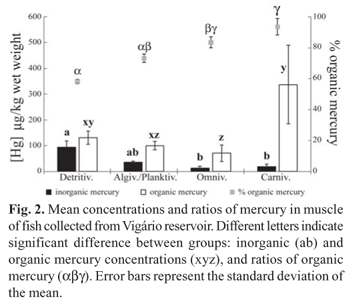Concentrations of organic (OrgHg) and inorganic mercury (InorgHg) were assessed in different fish tissues (liver, muscle, kidney, gut and gonads) and trophic levels collected in an impacted tropical reservoir in southeastern Brazil. Organic mercury concentrations in muscle were remarkably higher in the carnivorous species Hoplias malabaricus and Oligosarcus hepsetus. The ratios of OrgHg in relation to total mercury (%OrgHg) in muscle also varied according to the species trophic level: 93% for carnivores, 84% for omnivores, 73% for algivores/planktivores and 58% for detritivores. The %OrgHg in the gut tissue of carnivores (78%) was much higher than that found in omnivores (30%), possibly reflecting a process of trophic biomagnification in the reservoir. On the other hand, the InorgHg concentrations in muscle decreased with the trophic level increase, suggesting that this form of mercury did not biomagnify through the food web. Gonads contained the least total mercury, and approximately all of this mercury was represented by the organic form (83 to 98%). The kidney and the liver of all fish species contained less than 50% OrgHg. We suggest that the low %OrgHg in the liver is related to different capacities or strategies of OrgHg detoxification by the fish.
Feeding habits; Hydroelectric; Mercury species; Biomagnification; Bioaccumulation




